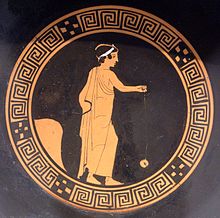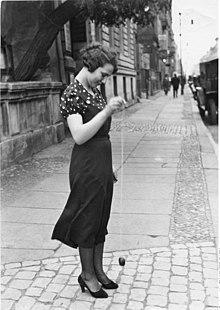Yo-yo
The yo-yo (also yo-yo ) is a toy, which consists of two discs that are connected by a central bar. A cord is attached to the middle bar and wound up. This allows the discs to be moved up and down - in a more or less skillful way.
Origin of the word and alternative expressions
There are two attempts to explain the term yo-yo :
- It comes from the Tagalog and means translated: come-come,
- It comes from the French root jouer (to play).
At the end of the 18th century, when the playground equipment experienced a wave of popularity in France and other European countries, the expression Joujou de Normandie was used, among other things .
Until then, however, the name Jo-Jo was not in use in the West . In France, the yo-yo was called "Bandalore" at that time. In Germany it was called roller wheel or shoe shoe (= Joujou). An older German name is Emigrant , Meyer's Konversationslexikon from 1889 still knows the expression Joujou .
One of the first mentions of the name "Yo-Yo" comes from " Scientific American " magazine from 1912.
history
The exact place of origin of the yo-yo is controversial; China , Greece or the Philippines are considered likely candidates .
The National Museum of Athens in Athens houses a vase depicting a boy playing yo-yo and a terracotta disk that served as a yo-yo.
Reports from the Philippines are known from the 16th century that hunters hid in trees and hurled boulders tied to ropes up to six meters in length at prey, whereby the boulders could be pulled up and thrown down again several times. It is more than doubtful whether these devices can actually be regarded as the forerunners of the yo-yo. The fact is, however, that the yo-yo has enjoyed great popularity as a children's toy in the Philippines for a long time.
Images of people playing yo-yo from France are known from the end of the 18th century . Between 1790 and 1794 the yo-yo was a pronounced fad that reached the highest social classes and also spread to Germany. The name Joujou de Normandie comes from this time .
The first US patent was owned by James L. Haven and Charles Hettrich in 1866.
Pedro Flores , a Filipino immigrant to the United States , brought his yo-yo with him and in 1928 founded a company of that name to manufacture yo-yos. The company was bought by Donald F. Duncan Sr., who contributed to the great popularity of the yo-yos with efficient advertising. In the late summer of 1932, Siegfried Kracauer from France reported on “Yo-yo” as “the latest fashion game that has started its triumphant advance” and describes it as follows: “A kind of chewing gum for the hand.” The principle of the free-wheel yo-yos patented Duncan in 1932. In 1962 he sold 45 million yo-yos. Duncan had the brand name "yo-yo" registered, but this was withdrawn from him years later because the term "yo-yo" has become common property.
The National Yo-Yo Museum is located in Chico , California , where you can admire many historical things about the yo-yo, as well as Tom Kuhn's largest wooden yo-yo in the world (weighing 123 kg).
Every year the World Yo-Yo Contest takes place, in which the title yo-yo world champion is awarded.
World Yo-Yo Day is held on June 6th each year in honor of Donald F. Duncan Sr.'s birthday .
Material, designs
The yo-yos used in Greece were made of terracotta , those made by Flores and Duncan from maple wood . Plastic has been the preferred material since around 1960 . Recently, however, yo-yos made entirely or partially of metal have also been found.
In the original yo-yos, the axis was firmly attached to the cord. A significant improvement was made around 1928 with the introduction of the cord loop by Flores. This allowed the axis to rotate freely within the cord loop. The effect was that the yo-yo continued to rotate when the cord was completely unwound, without immediately rewinding. With a small tug on the cord, the loop becomes tangled in the axis and the increased friction causes the yo-yo to wind up again. With this improved technique, a multitude of possible new tricks emerged.
There are generally two types of axes. On the one hand there are the already mentioned fixed axles with a loop of cord around them, on the other hand there are the so-called "transaxles". These can be further subdivided: mainly cheaper yo-yos have a transaxle in the form of a plastic ring wrapped around a rigid metal axis. A variation of this, which can be found in Duncan's ProFire, for example, are two (metal) rings that are placed on top of each other and then on a metal axle. There are also yo-yos with ball bearings (standard today). All transaxles reduce friction compared to a rigid axle and allow longer-lasting rotation.
Another variant of the modern yo-yos are centrifugal clutches . At a sufficiently high speed, these release the axle and the yo-yo can turn without the cord being wound up. If the rotation slows down, then the coupling “engages” and fixes the axis-cord connection and the yo-yo winds up. These yo-yos are available with various axis systems and are particularly suitable for beginners.
In addition, modern yo-yos often have little "response"; which describes how well the yo-yo reacts to a jerk on the string. The property of coming back with a slight jerk is avoided in many modern yo-yos by enlarging the gap for the cord. Some modern yo-yos even only come back with a so-called "bind". With a bind, an extra layer of string is placed in the string gap, which creates friction on the yo-yo halves, which makes it possible to pull the yo-yo back with a jerk.
"Imperial (Standard) Shape" vs. "Butterfly Shape"
Shape describes the shape of the yo-yo:
Yo-yos with an imperial shape (round shape) are more suitable for so-called loop tricks and have a narrow cord gap. Yo-yos with a butterfly shape have a very wide cord gap and are therefore very suitable for string tricks (cord tricks).
See also the Chinese yo-yo variant diabolo .
Game types
In competitions, the participants are divided into different game classes, depending on how the yo-yo is played:
- A (or Single A): Play with a yo-yo.
- AA (or Double A): Play with two yo-yos, one per hand. Loop and wrap tricks are shown.
- AAA (or Triple A): Play with two yo-yos, one per hand. In contrast to AA , the focus here is on string tricks and not on loops.
- 4A (or off-string): The yo-yo's string is not attached to the axle. The yo-yo is played in a similar way to a diabolo .
- 5A (or Freehand): The yo-yo is not attached to the hand, but to a counterweight such as B. a cube.
- Team competition : Two to six players compete against each other in a team freestyle competition. The tricks are linked together in free improvisation.
society
- Yo-Yo Association Germany e. V. (GYYA)
Jojo effect
As a metaphor , the yo-yo also lends its name to the yo-yo effect in diets.
literature
- George Malko: The One and Only Yo-yo Book. Avon, New York 1978, ISBN 0-380-01900-0
- Yo-Yo trick book (PDF file; 2.92 MB)
- Hermann Wagner: Illustrated playbook for boys , Leipzig 1864, p. 135f. : The scroll wheel
Web links
- Wiktionary: yo-yo
- Detailed history of the Yo-Yo (English) ( Memento of 8 September 2015, Internet Archive )
- GYYA-German Yo-Yo Association e. V.
- Overview of yo-yo associations worldwide
- Yo-Yo-Wiki (English)
- Yo-Yo World Championship
- European Yo-Yo Championship
- Yo-Yo Tips ( Memento from March 4, 2016 in the Internet Archive )
swell
- ^ Hermann Wagner: Illustrirtes Spielbuch für Knaben , Leipzig 1864, p. 135f.
- ↑ Anonymous: History of Toys. The ball catcher, the jumping jack, the emigrant, the devil , in: Illustrirte Zeitung, III. Volume, No. 77, December 21, 1844 (Leipzig), p. 394, digitized . Reprinted under the name of Dr. Jenoner in Österreichisches Morgenblatt , 11th year 1846, no. 1–7, p. 2, 6, 10, 18, 22, 26, on the emigrant p. 22, digitized
- ↑ Anonymous: Lust for girls during the recovery hours at the castle in Feldbrunn. A collection of games for young people to amuse the mind and exercise the body for the tender sex; Vividly represented in a series of lovely color images . Vienna: Müller 1823, p. 36 digitized , image behind p. 32 digitized
- ^ Siegfried Kracauer: From a French seaside resort ( Frankfurter Zeitung of September 14, 1932). In: Siegfried Kracauer: Berlin side by side. Selected feature articles 1930–33. Edited by Andreas Volk. Edition Epoca, Zurich 1996, ISBN 3-905513-02-1 , pp. 294–301, citations: p. 298.
- ^ Patent specification Freilauf-Jo-Jo







